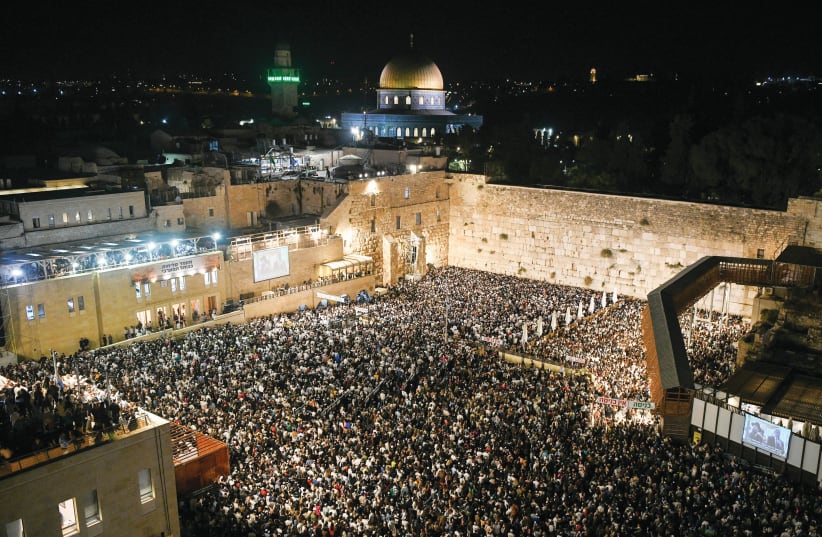“You put your mouth before your ears!”
That is how a 4th-century skeptic mocked the Israelites’ affirmation “na’aseh venishma” – all that God has spoken, “we will do and we will hear” (Exodus 24:7). Shouldn’t they have said, “we will hear” first and, only after hearing, affirmed “we will do”?
While it may sound counterintuitive for some, “na’aseh venishma” has become a catchphrase to express a deeply Jewish instinct about the relationship between behavior and meaning. The “hearing” – i.e., the appreciation, understanding, and meaning of the Torah – follows in the wake of the doing. Halacha (the system of Jewish practice), then, is more than mere instructions for how to act; it is a conveyor of meaning.
Jewish practice as a source of Jewish insight
This impulse to see Jewish practice as the source of Jewish insight reached a crescendo in the works of Rabbi Joseph Dov Soloveitchik. The introduction to his book On Repentance describes his methodology as “an intellectual process in which Halacha is ‘translated’ into epistemological and ontological categories.”
Rabbi Soloveitchik links “Halacha to theology and philosophy and from them to various insights into the life of the individual and society,” writes the book’s editor, Rabbi Pinchas Peli, in his introduction.


Rabbi Michael Rosensweig’s recent publication, Mimini Mikhael: Essays on Yom Kippur and Teshuvah, can be seen in many ways as a sequel to the Soloveitchik’s On Repentance. Besides sharing the same subject matter, Rabbi Rosensweig, as a devoted student of Rabbi Soloveitchik, shares his methodology. Mimini Mikhael is on a mission to uncover the profound conceptual significance of Yom Kippur with a certainty that the halachic material holds the answer.
One can get a hint of this certainly from the book’s bibliography. One of the book’s primary sources is the Rambam (also known as Maimonides). One might expect an exploration of Rambam’s philosophical tract, the Guide for the Perplexed, to determine his conception of Yom Kippur. However, a glance at the source index at the end of the book reveals that The Guide is not even cited once (although it is mentioned in Rabbi Yona Reiss’ forward to the book). Instead, Rambam’s great halachic code Mishneh Torah is the go-to text for this Halacha-centered methodology.
Mishneh Torah is particularly well suited for this pursuit, in part because the Rambam reorganized and categorized the largely free-ranging and tangential, halachic Talmudic conversational style. The Rambam divided the material into 14 books, which are further sub-categorized. Paying careful attention to which book, category and sub-category each law is placed in, reveals much about how the Rambam conceived them.
For example, the line “All are obligated to repent and confess on Yom Hakipurim” does not appear in Mishneh Torah’s “Laws of Yom Kippur” but rather in its “Laws of Repentance.” Why is the special requirement of confession and repentance on Yom Kippur absent from the laws of Yom Kippur?
Rabbi Rosensweig answers: “To really appreciate the uniqueness of Yom Kippur and its impact, one must appreciate that it is designed and intended to have a transformative impact on the rest of the year. Yom Kippur necessarily connects and interacts with halachic values and motifs that are indispensable all year round.”
He explains that the essence and telos of Yom Kippur demands that its nature become integrated with the rest of the year.
That is the conceptual explanation for the unusual placement of the obligation to confess and repent on Yom Kippur in a section of Mishneh Torah (its laws of repentance) that is not limited to Yom Kippur rather than in the laws of Yom Kippur.
He finds further evidence of this notion in another passage of the code. According to the Talmud’s presentation, there is a general requirement to start the observance of holidays and Shabbatot before their astrological onset (sunset) and to extend their observance into the following night. The Rambam codifies this Halacha in the laws of Yom Kippur and never mentions any such requirement for the other holidays. He seems to be either limiting this principle to Yom Kippur or emphasizing its centrality for Yom Kippur. Rabbi Rosensweig deduces that the extension of Yom Kippur into the days preceding and following it “reflects the idea that we must prepare for Yom Kippur and that Yom Kippur’s impact must extend throughout the rest of the year.” More than any other single day, Yom Kippur must be a transformative day that affects who we are all the other days of the year.
The examples above are just the tip of the iceberg. Rabbi Rosensweig’s careful and meticulous reading of the broad corpus of halachic texts produces a plethora of sophisticated, subtle, and inspirational insights over the book’s 18 chapters. His writing is extremely clear and readable. This all makes Mimini Mikhael a powerful contribution to the conceptual study of the laws of Yom Kippur and repentance and a great introduction to the genre of conceptual halachic thinking in general. Rabbi Rosensweig’s work is a fantastic contemporary reverberation of na’aseh venishna – Halacha is the source of meaning.
- Mimini Mikhael
- By Rabbi Michael Rosensweig
- Maggid
- 360 pages; $29.95
